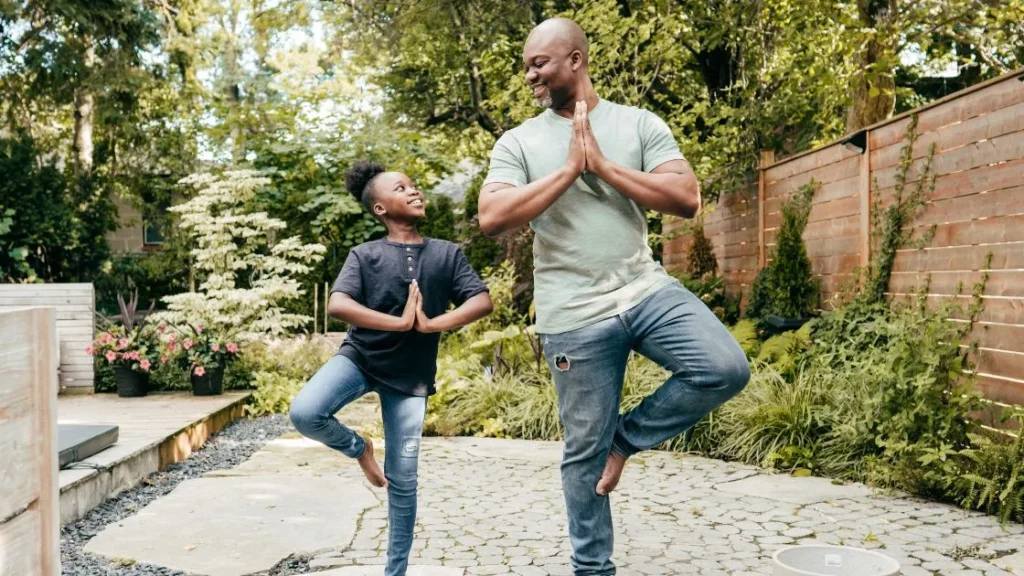Body Positivity: What You and Your Kids Should Know!

Body positivity promotes love and acceptance of our bodies, regardless of societal standards. It’s vital to understand the movement’s nuances and assist children in developing a healthy body image without over-focusing on appearance.
Teaching children that their self-worth extends beyond their looks can help them cultivate a strong sense of identity and confidence.
Supporting children in embracing body positivity involves recognizing the challenges they face in today’s image-driven society. It’s essential to address the unrealistic standards perpetuated by the media and to celebrate body diversity. By providing a nurturing environment that fosters self-acceptance and self-love, we can encourage children to develop positive relationships with their bodies.
Understanding Body Positivity
The Origin of the Body Positive Movement
The body-positive movement emerged in the 1960s, aiming to dismantle societal prejudices against a person’s marginalized body type, including fat and disabled individuals. The movement has since expanded to encompass people of all races, genders, and ages, working towards a world where no one’s body is devalued.
Understanding the historical roots of body positivity allows us to appreciate the ongoing struggle for acceptance and the need to continue supporting marginalized communities. Educating children about the movement’s origins can help them become more compassionate and empathetic toward others.
The Importance of Acknowledging Marginalized Bodies
Genuine body positivity involves recognizing the challenges faced by marginalized bodies and addressing the societal structures that perpetuate these prejudices. By acknowledging the struggles of others, we can better understand the importance of empathy and solidarity in promoting an inclusive environment.
Encourage children to learn about the experiences of people from diverse backgrounds and to respect the differences that make each person unique. This awareness can help them become more understanding and accepting of others, fostering a sense of compassion and unity.
Potential Drawbacks of the Body Positivity Movement
Unintended Reinforcement of Image-Consciousness
Some experts argue that an excessive focus on body positivity may unintentionally reinforce image consciousness, leading individuals to obsess over their bodies. It’s essential to strike a balance between promoting self-acceptance and fostering a fixation on appearance.
To prevent this issue, emphasize the importance of overall well-being and holistic self-worth, rather than focusing solely on physical appearance. Encourage children to recognize their innate value and the many aspects of their lives that contribute to their sense of self.
The Reality of Loving Your Body Every Day
“It’s normal to have days when you don’t love your body as much. It’s essential to acknowledge that loving every part of your body every day may not be realistic. It’s crucial to teach children that it’s okay to have these moments and that their worth remains unchanged”.
Rachel Goldman PHD
Help children understand that their feelings towards their bodies can fluctuate, and that’s normal. Encourage them to practice self-compassion and develop coping strategies for navigating challenging days.
The Misdirection of the Body Positivity Movement
Straying from the Original Purpose
The current body positivity movement often emphasizes self-love without addressing the systemic barriers affecting marginalized bodies. True body positivity should concentrate on advocating for societal change so that all bodies are accepted.
It’s crucial to remind children that body positivity goes beyond individual self-love, encompassing broader societal issues. Encourage them to become advocates for change by supporting inclusive representation and challenging discriminatory practices.
The Need for Societal Change
To create a more inclusive society, it’s essential to focus on dismantling systemic barriers affecting marginalized individuals and promoting the acceptance of all types of bodies. Encourage children to recognize the power they have to contribute to this change, both in their immediate environment and society as a whole.
By nurturing a sense of social responsibility and empathy, children can become agents of change and help create a more inclusive world. Discuss with them the importance of standing up against discrimination and promoting diversity in all aspects of life.
The Importance of a Healthy Body Image
Connection to Self-Esteem and Mental Health
A healthy body image is crucial for overall self-esteem and mental well-being. Feeling good about one’s body leads to a more balanced attitude towards eating and physical activity. A positive body image enables individuals to focus on their health and well-being instead of obsessing over their appearance.
Educate children about the connection between a healthy body image and their mental health, emphasizing that a strong sense of self-worth is essential for overall happiness and success in life. Encourage them to pursue activities that foster self-confidence and personal growth.
Risks of an Unhealthy Body Image
An unhealthy body image can result in low self-esteem, depression, social withdrawal, or eating disorders. It’s essential to recognize the signs of an unhealthy body image and intervene early to prevent long-term consequences on a child’s well-being.
Discuss with children the potential risks associated with an unhealthy body image, emphasizing the importance of maintaining a balanced perspective on appearance and focusing on overall health. Provide them with resources and support to help them navigate challenging situations and foster a positive self-image.
Fostering a Healthy Body Image in Children
Conveying the Right Messages
Help your children appreciate their bodies for their abilities and skills, rather than their appearance. Encourage open conversations about body changes and the absence of a “perfect” body. Emphasize the importance of self-acceptance and the understanding that each person’s body is unique and valuable.
Provide children with positive role models who exemplify diverse body types and who celebrate their bodies for what they can do, rather than how they look. This exposure can help children develop a more inclusive and accepting view of themselves and others.
Creating a Supportive Environment
Creating a supportive environment involves actively challenging societal norms and promoting body diversity. Be mindful of the messages conveyed by media and advertising, and engage in discussions with children about the unrealistic expectations often perpetuated in these outlets.
Encourage children to participate in activities that boost their self-esteem and help them recognize their innate value, such as sports, arts, or volunteering. By nurturing their talents and interests, they can develop a strong sense of identity that extends beyond their physical appearance.
Fostering a healthy body image and embracing body positivity is crucial for a child’s overall well-being. By providing a supportive environment, encouraging open communication, and promoting self-acceptance, we can help children develop a strong sense of self-worth and a positive relationship with their bodies.

Create a Positive Environment
Surround your children with positive role models and supportive environments that celebrate diversity in body shapes and sizes. Encourage them to engage in activities and hobbies that promote body acceptance and self-love, such as yoga, dance, or art. It’s crucial to create a safe space where they can discuss their feelings and concerns without judgment.
Encourage Healthy Habits
Promote healthy habits in your children by emphasizing the importance of regular physical activity, balanced nutrition, and self-care. Teach them the value of taking care of their bodies to improve overall well-being, rather than focusing on achieving a specific body shape or size. Encourage them to engage in activities they enjoy, and emphasize the importance of fueling their bodies with nourishing foods to support their growth and development.
Address Body Shaming and Bullying
Teach your children how to handle body shaming and bullying effectively. Encourage open discussions about their experiences, and equip them with the tools to stand up for themselves and others. It’s important to foster empathy and understanding, teaching them that it’s not acceptable to judge or discriminate against someone based on their appearance.
Focus on Achievements and Personal Growth
Help your children recognize their personal growth and accomplishments, rather than focusing solely on their physical appearance. Celebrate their achievements, whether it’s academic success, overcoming challenges, or learning new skills. Encourage them to pursue their passions and interests, building a strong sense of self-worth and identity that is not reliant on their physical appearance.
Helping children develop a healthy body image is essential for their emotional, mental, and physical well-being. Instilling a sense of self-worth that extends beyond physical appearance will set the stage for a lifetime of confidence and self-acceptance. Here are some additional strategies to further support a healthy body image in children:
Encourage Media Literacy
Children are constantly exposed to various media sources that often present unrealistic body ideals. Help your child develop critical thinking skills and media literacy by discussing the images and messages they encounter.
Explain the use of photo editing, lighting, and other techniques used to create perfect-looking images, and emphasize that these images do not represent reality. Encourage them to question the messages they receive and to seek out diverse and body-positive media.
Model Positive Self-Talk and Behavior
As a parent or caregiver, you play a significant role in shaping your child’s perception of their body. Be mindful of your self-talk and behavior related to body image.
Avoid making negative comments about your own or others’ bodies, and focus on the positive aspects of your physical appearance and abilities. Children often adopt their parents’ attitudes and beliefs, so modeling a healthy body image and self-acceptance can have a lasting impact.
Validate Their Feelings
It’s normal for children to experience insecurities about their bodies as they grow and develop. Validate their feelings and concerns while gently guiding them to focus on their strengths, abilities, and unique qualities. Encourage them to express their emotions through conversation, writing, or art, and remind them that their worth extends far beyond their physical appearance.
Foster a Supportive Peer Group
The influence of peers is significant when it comes to body image. Encourage your child to surround themselves with friends who are supportive, accepting, and non-judgmental. Discuss the importance of standing up for themselves and others in the face of body shaming or bullying. Help them develop strong communication and assertiveness skills to navigate challenging social situations.
Educate about Puberty and Body Changes
As children enter puberty, their bodies undergo significant changes. Providing age-appropriate information about puberty and body development can help alleviate anxiety and promote understanding. Normalize the changes that occur during this time, emphasizing that everyone develops at a different pace and that these changes are a natural part of growing up.
Offer Positive Reinforcement
Regularly offer your child positive reinforcement, praising their accomplishments, and efforts in various areas of their life. This will help build their self-esteem and remind them that their worth is not solely tied to their appearance. Focus on qualities such as kindness, resilience, creativity, and determination, which contribute to a well-rounded sense of self.
Encourage Self-Expression
Allow your child to express their individuality and personal style through clothing, accessories, and hobbies. Support their choices and encourage them to embrace their uniqueness. This will help them develop a strong sense of self and confidence in their own identity.
By incorporating these strategies into your parenting approach, you can create a supportive and nurturing environment that fosters a healthy body image in your child. Remember, the most important thing is to provide unconditional love and support, emphasizing their worth beyond their physical appearance.
Conclusion
Instilling a healthy body image in children is crucial for their overall well-being and self-esteem. By focusing on abilities and personal growth, promoting healthy habits, and creating a positive environment, parents can help their children develop a strong sense of self-worth that is not dependent on appearance. Encourage open conversations, address body shaming and bullying, and celebrate individuality to create a strong foundation for a healthy body image.






